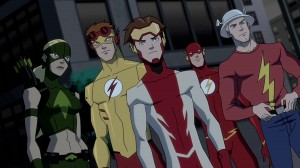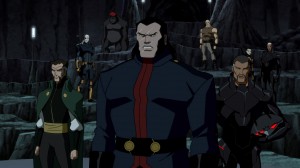Young Justice: In Memoriam by Jerry Whitworth
On March 16, 2013, the television series Young Justice came to an end with the final broadcast of the show on Cartoon Network as part of the DC Nation programming block. While no reasons have been given for the show’s end, in truth there has yet to even be confirmation of its demise by the network, there are a number of reasons that have been speculated upon: poor sales of the toyline, Cartoon Network’s mishandling of its schedule, jumping ahead in time for the second season, the rising cost of hand-drawn animation, the show not reflecting more of what DC Comics is currently producing in their titles, or Cartoon Network’s penchant for canceling shows when they reach a “magic number.” Some, often jokingly, attribute the series’ end to showrunner Greg Weisman (Disney’s Gargoyles, Spectacular Spider-Man) who produces critically-acclaimed series with cult-like followings that only last two seasons. Whatever the reason, the move has generated outrage from the show’s fervent community who have made the show trend on Twitter during broadcasts, sign petitions trying to save the program (one on Change.org reaching over 32,000 signatures), and have begun a letter writing campaign directed at Cartoon Network. The community has pushed for fans to purchase Young Justice paraphernalia such as the DVDs and trade paperbacks of its comic book and reportedly individuals close to the show’s producers have generated a survey in order to show interest in the program’s continuation. Only time will tell what effect these efforts will have. At this time, however, the show has no future and those close to it have moved on to other projects. Lets take a look at the show from its beginning to its end.
In 2009, Disney purchased Marvel Comics and all of its properties. On air at the time was the critically-acclaimed series Spectacular Spider-Man produced by Greg Weisman and Victor Cook (Scooby-Doo! Mystery Incorporated) for Sony Entertainment and airing on Kids’ WB! By the time of the acquisition, the second season was on air and would be moved to the network Disney XD. The show, despite its success, would be canceled with its second season. Simply put, Disney did not want to have its competitor Sony making a Spider-Man television series and so the show was killed to make way for the Disney produced Ultimate Spider-Man. With Jeph Loeb (Batman: The Long Halloween, The Ultimates 3) taking control of Marvel’s television division, he called for an end to animated series with ongoing narratives which, combined with Disney purchasing Marvel, resulted in the end of virtually all animated Marvel series. During this time, DC Comics had been producing direct-to-video animated films employing creators such as Brandon Vietti, who directed Batman: Under the Red Hood and Superman/Doomsday (as well as working on television series like Batman: The Brave and the Bold, The Batman, and Legion of Super-Heroes), and Phil Bourassa, who provided character designs for Justice League: Crisis on Two Earths and Justice League: Doom (Bourassa would also assist Sean “Cheeks” Galloway on character designs for Spectacular Spider-Man). Sam Register, Executive Vice President of Creative Affairs of Warner Bros. Animation, wanted to develop a new animated series based on young heroes of the DC Universe that would be significantly different than the previous such series Teen Titans. This idea gained considerable traction with the cancellation of Spectacular Spider-Man as Register hired Weisman soon after, pairing the creator with Vietti and tasking the duo with developing the series. Bourassa would join the team as character designer.
Likely Greg Weisman’s most well known series before Young Justice in Gargoyles and Spectacular Spider-Man would play into how the series would be developed. With Gargoyles, Weisman created an entire world filled with three-dimensional characters, rules and guidelines those in the world must follow, and a history rooted in mythology, folklore, and the works of William Shakespeare. The series’ players were each unique and complex, rarely all good or all evil and would from time to time change between what role they served. The series would develop a huge following, especially after the end of the show with the convention the Gathering of the Gargoyles which ran yearly and across the United States and Canada from 1997 to 2009 (a worldwide appeal, a nod to the show would even appear in the anime series The Big O). For Spectacular Spider-Man, Weisman and Victor Cook didn’t subscribe to any one version of Spider-Man, borrowing elements from the comics (main and Ultimate Spider-Man) and the film series, while at the same time making the series their own by using their own original ideas (such as having the primary antagonist the Big Man contract Norman Osborn to create super-villains to battle Spider-Man so he would be too preoccupied to smash organized crime). For Young Justice, Weisman and Vietti generated a very dense and interconnected world where an ancient cabal of evil known as the Light has operated in the shadows for centuries. As the Light pushed for world domination, heroes would emerge such as the Justice Society of America and Justice League of America to stop them (generally unaware they faced such a large, structured, clandestine organization). As the series started, a handful of sidekicks for heroes in the League wanted independence to operate at least in part on their own, feeling they earned the responsibility. For the cast of young heroes, Weisman and Vietti elected to pick heroes from across the different ages of DC Comics, combining old sidekicks like Dick Grayson as Robin, Wally West as Kid Flash, and Roy Harper as Speedy, more recent heroes like Superman clone Superboy and Miss Martian, and original characters such as Kaldur’ahm as Aqualad and the Krypto-inspired Wolf.
The series would be a hit. Viewers took heavily to it, many cosplaying as the characters at comic book conventions, and would win an Emmy for its character design. Arguably the show’s star Aqualad would be adapted for DC Comics by Geoff Johns and featured in the event Brightest Day as the son of Black Manta whose powers to control water are awakened by the White Lantern Battery. The show was picked up for a second season after airing nine of its twenty-six initial episodes. Originally a ten episode mini-series, Cartoon Network would later opt for Weisman and Vietti to produce twenty episodes for the second season. Named Young Justice: Invasion, the series jumped ahead five years where Aqualad had betrayed his team to become Black Manta’s right-hand man following the death of teammate Aquagirl, Kid Flash and Artemis retired from the superhero game, Dick Grayson became Nightwing to lead the team, two Robins would inherit the mantle with Tim Drake the latest to don it (the second, Jason Todd, having died), and the alien race known as the Reach is invading Earth with the help of the Light. Finding the people of Earth hold the meta-gene which can grant people amazing powers, the Reach wanted to cultivate it to make an army of super-powered soldiers, their initial result being a homage to the Super Friends in creating analogies for Black Vulcan (mashed up with Static), Apache Chief, El Dorado, and Samurai (elements of the story borrowed from the Invasion comic book event).
Unfortunately, hiatuses on the part of Cartoon Network took its toll on the show. After nine episodes into the first season, the show took a six month break to give animators time to produce more episodes. After nine more episodes, a four month break. The first season finale was followed a week later with the second season premier but after seven episodes, the show went on a three month hiatus. The series would return for only two more episodes before a three month hiatus which no one to this day knows for what reason (the episodes done and ready to air and DC Comics actively promoting the show at the San Diego Comic-Con International proudly heralding its return only to see two episodes air). The hiatuses would ultimately lead to the cancellation of the accompanying comic book series, which was written in the same world as the show by Greg Weisman running side-by-side with the animated series. It would be four episodes into the show’s return from hiatus that the non-announcement came the show was canceled when it was left off the schedule and those working on the series announced there are no plans at that time to continue the show.
In a recent interview, Brandon Vietti admitted the series was carefully planned out at least three seasons from the show’s conception. Elements of a third season are obvious from the events of the series finale. Some notable elements include the addition of Static to the Team (and the offer of Black Lightning to mentor him), Lex Luthor’s nomination to Secretary General of the United Nations (drawing allusions to Luthor’s election to President of the United States), Artemis adopting the identity of Tigress, and the death of Wally West drawing allusions to the demise of Barry Allen in Crisis on Infinite Earths and the death of Bart Allen from The Flash: The Fastest Man Alive. Impulse picking up the mantle of Kid Flash draws allusions to Geoff Johns’ Teen Titans run and West’s death brought together Robin and Wonder Girl in a somewhat similar fashion to Superboy’s death in Infinite Crisis. Likely the greatest reveal was the final one introducing Darkseid as the Light’s ally, something comic book fans have suspected since the first season, which could have meant elements of Legends and The Great Darkness Saga could have played out in the third season. Should the Legion of Super-Heroes have made an appearance, perhaps it would have meant the revival of Wally West in a similar fashion to what played out in Final Crisis: Legion of 3 Worlds with Bart Allen. Of course, this is all speculation that may very well never be confirmed or denied. There is, however, one more piece of Young Justice material yet to premier. On September 10, 2013, the video game Young Justice: Legacy will hit store shelves set within the five year gap between the first and second seasons.
The collapse of Young Justice at Cartoon Network could have long term effects on the station’s relationship with DC Comics. While the DC Nation programming block will return with Beware the Batman and Teen Titans Go!, CN has moved comic adaptations of their properties away from DC. A year ago, one of CN’s hottest properties in Adventure Time would begin being published by Boom! Studios and last month it was announced a partnership will begin with IDW Publishing offering the publisher access to the entire CN catalog. The situation is quite strange considering both DC Comics and Cartoon Network belong to Warner Bros and in the past Warner has adamantly avoided sending projects out-of-house if it is capable of producing the work itself (so far as purchasing Rocksteady Studios following its success with the Batman: Arkham video game series and Midway Games’ assets following its production of Mortal Kombat vs. DC Universe). CN’s move may very well hint at irreconcilable differences between the companies. A year ago, CN recorded its first jump in ratings in five years after years of falling (the previous year having fell by double digits). One of the crown jewels in this spike came from Young Justice (at times having triple digit rises in ratings from the previous year) and now only time will tell what effect its loss will have on the station. The while, those involved with Young Justice have moved on. Greg Weisman has his first novel Rain of the Ghosts set to be published in December. Brandon Vietti produced and directed a film featuring Scooby-Doo and the superstars of the WWE set for release next year.











Such a great show. They better come back.
Why bother leaving a show with a cliffhanger? Maybe they will create a new Justice League or perhaps a movie. Who knows
I think WB should send their DC shows somewhere else- clearly Cartoon Network doesn't appreciate good superhero shows. They should try another channel. Also, bring back Young Justice and Green Lantern!
Dc should take there shows to the hub channel
i said the same thing. transformers prime seems to have all the time in the world and has some quality episodes. i think young justice and green lantern would take off on that network.
I agree.
I'm hoping it comes back on the Hub. And while we're at it, a direct-to-video film with how Kaldur found out who his father was, how Tula died, why a bunch of people quit the team, and what happened to Ocean Master that Manta took his spot.
They should create a DC channel, they got enough shows over time to fill it up to the brim.
I simply cannot understand what their thinking other than there must be people up there with gigantic egos, and think that these little reindeer games add kudos to ending shows at their apex rather than do the work to make them more successful. The best thing for Warner to do is just clean house since they own it, apply better staffing that would allow DC to do its thing and come up with better gidelines for putting out and canceling a series.
Warner could clean house and concentrate on putting out quality animated series, but that would take away from them competing with Disney on who can put out the most live-action shows that feature "tween-agers" so annoying they make you wanna breathe in car exhaust.
This has been a rough year all around for series. Outside of comics, I was really bummed about Tron and MotorCity getting the can.
I enjoyed YJ. I don't see how bringing back Teen Titans and making even more…silly can ever be any better. All in the sake of kids? Imo adults watch more cartoons than kids anyway lol And, as long as there are superheroes kids will watch anyway, no matter who the content is directed towards.
This was a really great show. It's a shame to see it go. Gotta go sign some petitions!
So stupid. The show had high ratings among a broad demographic. So they're replacing it with a stupid chibi cartoon that has appeal to who? I'm not going to watch it, I don't knw who will. With YJ you got adults attention also, children will watch anything.
http://www.themarysue.com/kickstart-young-justice/